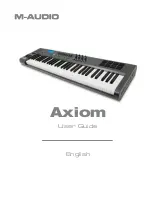
24
Panel Descriptions
POWER ON Switch
Press to turn the power on/off.
→
AC Inlet
Connect the included power cord to this inlet.
USB
USB MEMORY Slot
A USB memory (sold separately) can be inserted here.
* Never insert or remove a USB memory while this unit’s power is
on. Doing so may corrupt the unit’s data or the data on the USB
memory.
* Carefully insert the USB memory all the way in—until it is
firmly in place.
USB MOUSE Connector
Connect the USB mouse (sold separately).
→
USB COMPUTER Connector
This connector lets you use a USB cable to connect your
computer to the Fantom-G.
→
DIGITAL AUDIO IN/OUT Connectors
(S/P DIF COAXIAL)
These are coaxial-type S/P DIF format digital in/out connectors.
These connectors input and output a digital audio signal
(stereo). The output signal is identical to the signal that is output
from the OUTPUT A (MIX) jacks.
* S/P DIF is a digital interface format used for consumer digital
audio devices.
* If you switch off the power to an external device that is
connected to the DIGITAL AUDIO IN jack or disconnect the
cable, noise may subsequently be heard in the input from
DIGITAL AUDIO IN. If this occurs, correctly reconnect the
external device, or turn off the Fantom-G’s [MIX IN] switch.
MIDI Connectors (IN, OUT, THRU)
These connectors can be connected to other MIDI devices to
receive and transmit MIDI messages.
FOOT PEDAL
CTRL (CONTROL) 1, 2 Jacks
You can connect optional expression pedals (EV-5, etc.) or
optional pedal switches (DP series etc.) to these jacks. By
assigning a desired function to a pedal, you can use it to select or
modify sound or perform various other control.
→
925
* Use only the specified expression pedal (EV-5; sold separately).
By connecting any other expression pedals, you risk causing
malfunction and/or damage to the unit.
HOLD Jack
An optional pedal switch (DP series, FS-5U etc.) can be
connected to this jack for use as a hold pedal.
→
This can also be set so it supports the use of half-pedaling
techniques. So, after connecting an optional pedal switch (DP
series etc.), you can employ pedal work to achieve even finer
control in performances in which piano tones are used.
AUDIO INPUT
MIC/GUITAR Jack
You can connect either a mic or guitar. Set the Switch as appropriate
for the device you’ve connected to the MIC/GUITAR jack.
* This instrument is equipped with balanced (XLR/TRS) type
jacks. Wiring diagrams for these jacks are shown below. Make
connections after first checking the wiring diagrams of other
equipment you intend to connect.
fig.XLR/TRSJack.eps
MIC/GUITAR LEVEL knob
Controls the volume of the mic/guitar input.
LINE Jacks (L, R)
Connect a line-level device such as an audio device (e.g.,
portable music player) or keyboard. If you want to use mono
input, connect to the L jack (p. 258).
LINE LEVEL knob
Controls the volume of the line input.
OUTPUT
OUTPUT A (MIX) Jacks (L (MONO), R)
These jacks output the audio signal to the connected mixer/
amplifier system in stereo. For mono output, use the L jack.
→
OUTPUT B Jacks (L, R)
These jacks output the audio signal to the connected mixer/
amplifier system in stereo.
INDIVIDUAL 1–4 Jacks
These jacks output audio signals in mono to an amp or mixer.
* The setting determining whether these jacks are used as stereo
OUTPUT jacks or monaural INDIVIDUAL jacks is made with
the Output Assign setting.
→
PHONES Jack
This is the jack for connecting headphones (sold separately).
→
Rear Panel
1
2
3
4
5
6
7
8
9
1
2
3
4
5
6
GUITAR (Hi-Z)
Guitar (High impedance supported)
PHANTOM OFF
Dynamic Mic: 1/4“phone plug (balanced or
unbalanced), XLR connector
PHANTOM ON
Condenser Mic: XLR connector (48 V phan-
tom power supported)
* If you don’t need phantom power supply,
select the PHANTOM OFF position.
7
Min
Max
Min
Max
8
9
Fantom-G_r_e.book 24 ページ 2009年7月2日 木曜日 午後2時55分
















































